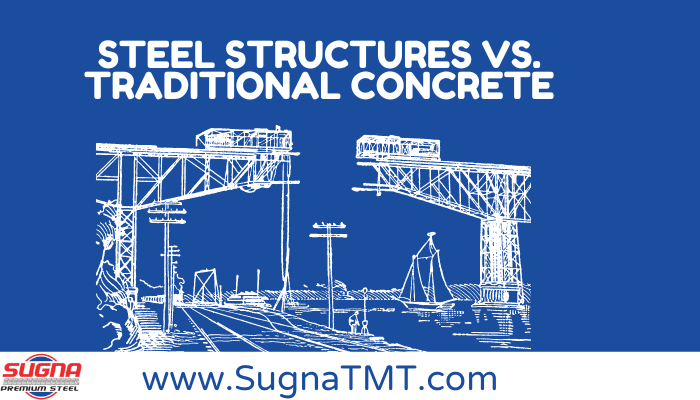The construction industry is continually evolving, with new materials and techniques being introduced to meet the growing demands for stronger, more durable, and sustainable structures. Two of the most widely used materials in construction today are steel and concrete. Each has its own set of advantages, but the choice between steel structures and traditional concrete often boils down to the specific requirements of the project. However, one common element in both types of structures is the use of TMT (Thermo-Mechanically Treated) bars, which have revolutionized the way buildings are constructed. In this blog post, we will explore the differences between steel structures and traditional concrete, and why TMT bars are increasingly being seen as the future of construction.
The Basics: Steel Structures vs. Traditional Concrete

Before diving into the role of TMT bars, it’s important to understand the fundamental differences between steel structures and traditional concrete.
-
Steel Structures
Steel structures are primarily composed of steel components, such as beams, columns, and trusses, which are assembled to create the framework of a building. Steel is known for its high tensile strength, flexibility, and durability, making it ideal for constructing tall buildings, bridges, and industrial structures. Steel structures are also quick to assemble, allowing for faster construction timelines.
-
Traditional Concrete Structures
Traditional concrete structures rely on reinforced concrete, which is a composite material made from cement, aggregates (such as sand and gravel), and water. The strength of concrete comes from the chemical reaction between these components, which hardens over time. Reinforcement is provided by embedding steel bars (rebar) into the concrete, which helps it withstand tensile forces. Concrete is known for its excellent compressive strength and resistance to fire and weathering.
The Role of TMT Bars in Construction
TMT bars have become a cornerstone in modern construction, whether it involves steel structures or traditional concrete. These bars are manufactured using a special thermo-mechanical treatment process that imparts superior strength, ductility, and corrosion resistance. Here’s why TMT bars are crucial in the construction of both steel and concrete structures:
-
High Tensile Strength
TMT bars are renowned for their high tensile strength, which makes them ideal for use in both steel and concrete structures. In steel structures, TMT bars provide the necessary reinforcement to withstand tensile forces, ensuring that the framework remains stable under various loads. In traditional concrete structures, TMT bars enhance the tensile strength of the concrete, preventing cracks and ensuring long-term durability.
-
Ductility and Flexibility
One of the standout features of TMT bars is their ductility, which allows them to bend without breaking. This flexibility is crucial in areas prone to seismic activity, as it enables the structure to absorb and dissipate energy from earthquakes without sustaining significant damage. Whether in steel or concrete structures, TMT bars contribute to the overall resilience of the building.
-
Corrosion Resistance
TMT bars are designed to resist corrosion, making them ideal for use in a wide range of environments, including coastal areas and industrial zones where the risk of corrosion is high. In traditional concrete structures, corrosion of reinforcement bars is a major concern, as it can lead to structural failure over time. TMT bars address this issue by providing long-lasting protection against rust and corrosion, thereby extending the lifespan of the structure.
-
Compatibility with Modern Construction Techniques
TMT bars are highly compatible with modern construction techniques, such as prefabrication and modular construction. Their high strength-to-weight ratio makes them easy to handle and transport, while their flexibility allows for precise bending and shaping to fit various design requirements. This versatility is particularly beneficial in steel structures, where TMT bars are used to create complex architectural designs.
Why TMT Bars Are the Future of Construction
Given the benefits of TMT bars, it’s clear why they are becoming the preferred choice for construction professionals around the world. Here’s why TMT bars are likely to shape the future of construction:
-
Enhanced Structural Safety
The use of TMT bars in both steel and concrete structures significantly enhances the safety of buildings. Their high tensile strength, ductility, and corrosion resistance ensure that structures can withstand a wide range of environmental and load conditions, reducing the risk of structural failure.
-
Sustainability
Sustainability is a key concern in modern construction, and TMT bars contribute to this goal by reducing the need for frequent repairs and replacements. Their durability and resistance to corrosion mean that structures built with TMT bars have a longer lifespan, which in turn reduces the consumption of raw materials and energy.
-
Cost-Effectiveness
While the initial cost of TMT bars may be higher than traditional reinforcement options, their long-term benefits make them a cost-effective choice. The reduced need for maintenance, repairs, and replacements translates to lower lifecycle costs for the structure, making TMT bars a smart investment for both steel and concrete buildings.
-
Adaptability to Innovative Construction Methods
As the construction industry continues to adopt innovative methods such as 3D printing, prefabrication, and smart construction technologies, TMT bars will play a crucial role in enabling these advancements. Their versatility and compatibility with modern techniques make them an essential component in the future of construction.
Conclusion
In the debate between steel structures and traditional concrete, both materials have their merits. However, the common thread that ties them together is the use of TMT bars, which have proven to be a game-changer in the construction industry. With their superior strength, ductility, corrosion resistance, and adaptability, TMT bars are not just a part of the present; they are the future of construction. Whether you are building with steel or concrete, incorporating TMT bars into your project ensures that your structure will stand the test of time, providing safety, durability, and value for years to come.

